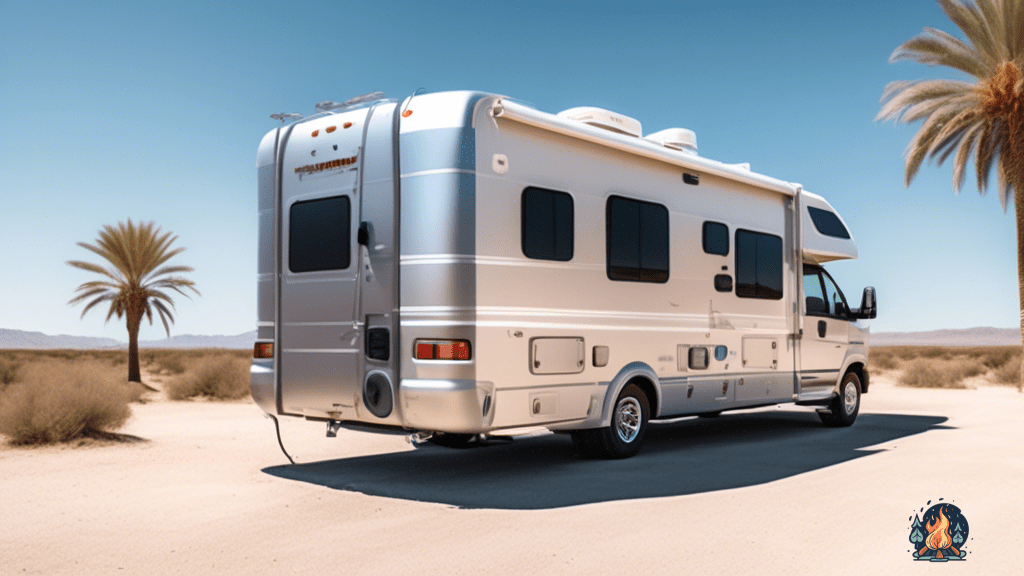Essential Tips For RV Generator Maintenance
by Kevin Fairbanks • Updated: January 21, 2024
Discover the must-know tips for RV generator maintenance to ensure a smooth trip. Don’t let a breakdown spoil your adventure – click here to keep your RV generator running smoothly!

Are you the proud owner of an RV and a generator? Well, buckle up because we’re about to embark on a maintenance journey that will keep your generator purring like a contented kitten.
In this article, we’ll be sharing some essential tips for RV generator maintenance that will ensure your trusty power source is always ready to go when you hit the road. So grab your toolbox and let’s dive in!
First things first, my friend – regular oil changes and filter replacements are the bread and butter of generator maintenance. Just like you need your morning coffee to function, your generator needs fresh oil and clean filters to keep humming along. Don’t be tempted to skip this step or your generator might start protesting with some loud and unpleasant noises, and nobody wants that.
And while we’re on the subject of fuel, be sure to keep an eye on those levels. It’s like feeding your generator – you wouldn’t want it to go hungry, would you? So make sure you keep it well-fed with fresh fuel and avoid any grumbling from your power source. Trust me, a happy generator is a happy camper!
Regular Oil Changes and Filter Replacements
Properly preserving your RV’s power source involves performing periodic oil changes and filter replacements to ensure optimal performance.
Now, I know what you’re thinking. "Oil changes? Filter replacements? Can’t I just let my RV generator do its thing and hope for the best?" Well, my friend, you could do that, but it’s kind of like giving your grandma a pair of roller skates and expecting her to win a gold medal in the Olympics. It’s just not gonna happen.
You see, oil changes and filter replacements are like giving your RV generator a spa day. They keep everything running smoothly and prevent any nasty surprises down the road. Just like you wouldn’t want your grandma’s roller skates to get rusty, you don’t want your generator’s oil to turn into a thick, sludgy mess. It’s all about keeping things fresh and clean.
So, grab your toolbox and get ready to pamper your power source. Trust me, your RV generator will thank you for it.
Checking and Maintaining Fuel Levels
Make sure you regularly check and maintain the fuel levels in your RV generator to ensure optimal performance. Fuel is the lifeblood of your generator, so it’s important to keep it well-fed and happy.
Here are some essential tips to keep your fuel levels in check:
- Fill ‘er up: Just like a hungry teenager, your generator needs to be fed regularly. Make sure to keep your fuel tank topped up to avoid any unexpected power outages. Plus, it’s always a good idea to have some extra fuel on hand in case of emergencies. You never know when you might need a little extra juice to power that impromptu karaoke session.
- Quality matters: When it comes to fuel, don’t settle for anything less than the best. Use high-quality gasoline or diesel fuel that meets the manufacturer’s specifications. This will help ensure that your generator runs smoothly and efficiently, without any hiccups or coughing fits.
- Keep it clean: Just like a picky eater, your generator prefers a clean fuel supply. Regularly check the fuel filters and clean or replace them as needed. This will help prevent any clogs or blockages that could impede the flow of fuel and affect your generator’s performance.
- Don’t be a hoarder: While it’s essential to have some extra fuel on hand, don’t go overboard. Storing large quantities of fuel for extended periods can lead to degradation and even pose a safety risk. So, make sure to use and rotate your fuel supply regularly to keep it fresh and avoid any unpleasant surprises.
By following these fuel maintenance tips, you’ll keep your RV generator running like a well-oiled machine. So go ahead, fuel up and power on with confidence. Happy travels!
Cleaning and Inspecting the Air Filter
Regularly inspect and clean your RV generator’s air filter to ensure optimal performance. Think of it as giving your generator a breath of fresh air! Just like you wouldn’t want to breathe in a bunch of dust and dirt, your generator doesn’t either.
And let’s be honest, a generator with a stuffy nose is not a fun generator to be around. So, take a moment every now and then to show some love to your generator’s air filter.
Cleaning the air filter is a breeze (pun intended). Start by locating the air filter housing, which is usually near the engine. Open it up and gently remove the air filter. Give it a good tap to get rid of any loose debris, or for an extra satisfying experience, blow on it like you’re extinguishing birthday candles.
Once you’ve done that, it’s time to give the filter a good cleaning. You can either wash it with soap and water or use compressed air to blow out the dirt. Just make sure it’s completely dry before putting it back in. Trust me, a wet air filter is not a good look for your generator.
So, take care of your generator’s air filter, and it will take care of you by providing reliable power for all your adventures.
Testing and Replacing Spark Plugs
When testing and replacing spark plugs in your RV generator, it’s important to ensure they are in good condition to maintain optimal performance. Here are three essential tips to help you with this task:
- Check the spark plug for signs of wear and tear. Look for any cracks, carbon buildup, or erosion on the electrodes. If you notice any of these issues, it’s time to replace the spark plug. Remember, a worn-out spark plug can lead to poor ignition and reduced fuel efficiency, so it’s best to address the problem as soon as possible.
- Use a spark plug tester to check the spark plug’s functionality. This tool will help you determine if the spark plug is producing a strong, consistent spark. Simply attach the tester to the spark plug wire and crank the generator. If you see a bright blue spark, the spark plug is working fine. However, if the spark is weak or nonexistent, it’s time for a replacement.
- Choose the right spark plug for your generator. Different generators require different types of spark plugs, so make sure to consult your generator’s manual or contact the manufacturer for the correct specifications. Using the wrong spark plug can result in poor combustion and damage to your generator’s engine. So, take the time to find the right spark plug and enjoy smooth and efficient operation of your RV generator.
Remember, maintaining your RV generator’s spark plugs is crucial for optimal performance. By following these tips, you can ensure your generator is ready to power your adventures on the road.
Happy camping!
Proper Storage and Winterization Techniques
To ensure your RV generator remains in optimal condition during periods of non-use, it’s crucial to properly store and winterize it.
Think of it like putting your generator into hibernation, just like a bear getting ready for a long winter nap.
First things first, you’ll want to make sure the fuel tank is empty or at least add a fuel stabilizer to prevent any nasty surprises when you wake it up from its slumber. Just imagine waking up from a long nap and finding a half-eaten sandwich next to you. Not a pleasant surprise, right? Same goes for your generator.
Next, don’t forget to remove the battery and store it in a cool, dry place. You don’t want your battery feeling like it’s on a tropical vacation while the rest of the generator is freezing its nuts and bolts off.
And speaking of nuts and bolts, give your generator a good cleaning before tucking it away. No one wants to wake up to a dusty mess, and your generator isn’t any different. A clean generator is a happy generator, and a happy generator is less likely to give you any trouble when it’s time to wake it up again.
So remember, store and winterize your RV generator like you would prepare for a long winter hibernation, and you’ll have a generator that’s raring to go when the warmer weather returns.
Frequently Asked Questions
How often should I clean the carburetor on my RV generator?
You, dear RV enthusiast, should clean the carburetor on your beloved generator at least once a year. Make sure to remove any gunk and debris to keep it running smoothly and prevent any cranky generator tantrums. Happy cleaning!
Can I use regular gasoline in my RV generator?
Sure, you can use regular gasoline in your RV generator. Just remember, it’s like feeding your generator comfort food. It’ll run, but for optimal performance, treat it to the premium stuff!
Is it necessary to use a fuel stabilizer in the RV generator?
Yes, it’s absolutely necessary to use a fuel stabilizer in your RV generator. Otherwise, you might as well be giving your generator a shot of espresso and expecting it to perform like a sleepy sloth. Don’t risk it, my friend.
How often should I check the battery levels in my RV generator?
Check your RV generator’s battery levels at least once a month. Did you know that a fully charged battery can maintain power for up to 8 hours? So, don’t forget to give it some TLC!
What are the signs that indicate my RV generator needs a professional inspection or repair?
If your RV generator starts acting like a diva, it’s time for a professional inspection. Weird noises, funky smells, and a lack of power are all signs that it needs some TLC from an expert.

Hi, I’m Kevin, a lifelong camping enthusiast and the voice behind Campfire Discoveries. From tent to RV to cabin camping, I’ve explored it all. Join me as we share stories and tips around the campfire, deepening our connection with the great outdoors.
Keep Reading
-
Maintaining Your RV Water System: Tips And Tricks
Keep your RV water system running smoothly with our expert tips and tricks for maintenance. Don’t miss out on our essential guide! Click now to learn more about RV Water System Maintenance.
-
Essential Campfire Safety Tips For Outdoor Enthusiasts
Learn the essential campfire safety tips you need for a safe and unforgettable outdoor adventure. Don’t risk it, click now to ensure a memorable trip!
-
Delicious Camping Breakfast Ideas For A Good Morning
Fuel your camping adventure with these irresistible breakfast ideas that will make your mornings in the great outdoors unforgettable. From hearty skillet meals to tasty campfire treats, discover delicious camping breakfast ideas and start your day off right! Don’t miss out – click here for a mouthwatering morning feast!



